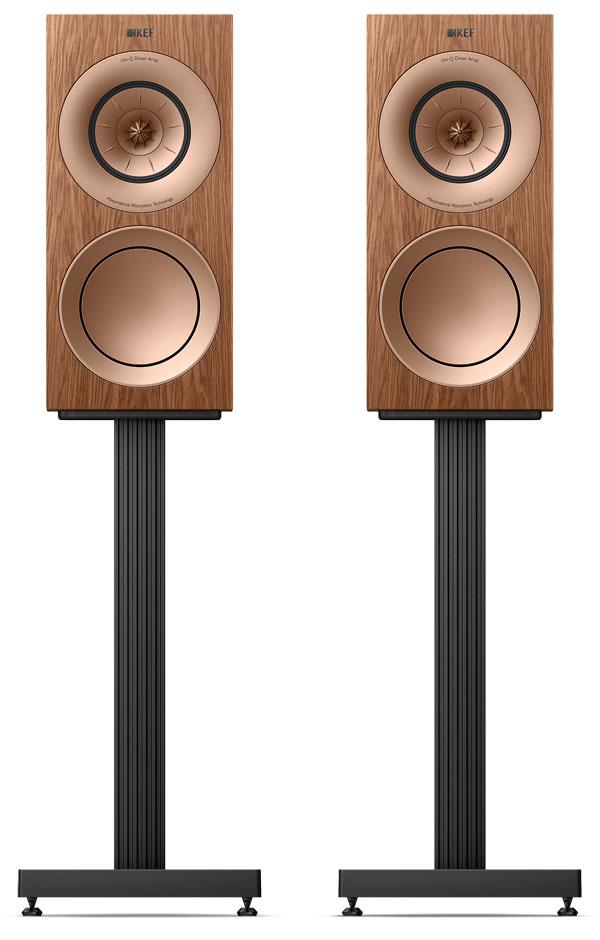KEF R3 Meta Loudspeaker

 KEF's innovative 'MAT' absorber has pushed the performance of Uni-Q to new heights. Now it's in the seven-strong R series
KEF's innovative 'MAT' absorber has pushed the performance of Uni-Q to new heights. Now it's in the seven-strong R series
It still surprises me that KEF's R series, which features seven models in total, includes only one standmount/bookshelf option. Surprising because compact speakers are extremely popular, and because the R series is the company's mid-tier proposition, above the entry-level Q and a considerable way below the Reference range. Yet the previous generation, which launched in 2018, featured just one standmount – the R3 – so it's deja vu five years later.
There has been a slight tweak to the overall line-up, however, because there are now two centre channel speakers (rather than just one) for home cinema installations, alongside three floorstanders and a Dolby Atmos-enabled 'upfiring' unit. But the most obvious change, and that which gives the £1900 R3 Meta its name, is the R series' adoption of KEF's 12th-generation Uni-Q driver, with metamaterial absorption technology (MAT).
Welcome, Mat
Originally featured on the LS50 Meta speaker [HFN Jun '21], and more recently gracing KEF's Blade One Meta [HFN May '22], LS60 Wireless [HFN Sep '22], and Reference 5 Meta [HFN Jun '23] loudspeakers, MAT will be a familiar concept to many HFN readers. But for those who have been living in a hi-fi cave, the technology (a 'joint development' between KEF and the Acoustic Metamaterials Group) is a thin, 100mm-diameter disc placed behind the Uni-Q driver array. Via its computer-modelled series of tiny resonators (precisely tuned channels), it claims to absorb 99% of rear-radiated sound for improved mid/treble performance. It's thus far more efficient, and better targeted, says KEF, than conventional damping methods using acoustic materials.

The MAT absorber is not the only addition to KEF's familiar 'single point source' Uni-Q, which mounts a 25mm aluminium dome tweeter (with 'tangerine' waveguide) within a 125mm aluminium midrange cone. Revisions 'to maximise the performance improvements that MAT delivers' include the R3 Meta's 'Shadow Flare' surround, originally designed for the Reference models, plus a new system to decouple the midrange motor – also now with a copper ring for reduced inductance/distortion – from the Uni-Q chassis. What's more, the tweeter gap damper and conical waveguide behind the dome have been revised, as has the crossover.
Foam Rolling
Mounted below the Uni-Q on the R3 Meta's baffle is a 165mm aluminium/paper bass driver, with a 50mm voice coil and vented magnet system. This is framed by a half-roll surround that results in an overall diameter matching that of the Uni-Q above. The bass driver operates below 450Hz (the mid/treble crossover is 2.3kHz) and claims a low-frequency reach down to 38Hz. Helping out here is the R3 Meta's bass reflex system, which features a rear-facing port with flexible rubber walls that is said to reduce airflow turbulence.
These ports can be 'shorted' by supplied foam bungs with a removable inner section. These are potentially useful in more space-limited set-ups, where the outer ring of the insert, or both parts, can be fitted to manage the bass output. In my experience, the R3 Meta is likely to sound at its best with some breathing room around the cabinet, toed-in by about 15° and with the ports unrestricted.
The R3 Meta's braced, constrained-layer-damped MDF cabinets are available in four finishes. Black Gloss, White Gloss and the Walnut shown here are standard across the range, and colour match the Uni-Q array and bass driver to the cabinet. For this standmount model there's also an Indigo Gloss Special Edition, which contrasts the enclosure finish with a copper-coloured Uni-Q, but without any price premium.
The look and feel of these speakers is remarkable considering the price point. We talk of trickledown technology, of which there's plenty here, but there's also an element of trickledown design: the R3 Meta is clearly a close relation to KEF's higher-end Reference 1 Meta sibling. KEF discusses the speaker's 'minimalist exterior', but there's a maximalist vibe to the quality of the finish, the seamless nature of the cabinet construction, and even the rear-panel binding posts. Another design element borrowed from higher up the KEF ladder, this in-house hardware provides access to the split crossover network via a (stiff) rotary and internal mechanism so there's no need to fiddle with external jumper bars. Overall, the R3 Meta presents itself very much as an alternative to the £7500 Reference 1 Meta, for those with shallower pockets.
![]() Coming Clean
Coming Clean
Listen to the R3 Meta and it's hard to avoid the notion that KEF's MAT absorber is having a very real impact [HFN Jun '21]. The output of this three-way speaker is impressively clean sounding, which brings superb clarity and resolution to the music. It sounds open and inviting, but avoids brightness, while the 165mm woofer provides a surprisingly opulent bass with plenty of detail of its own, and not a little sturm und drang when demanded. From top-to-bottom, the R3 Meta sounds glorious, and an absolute steal at the price.

















































